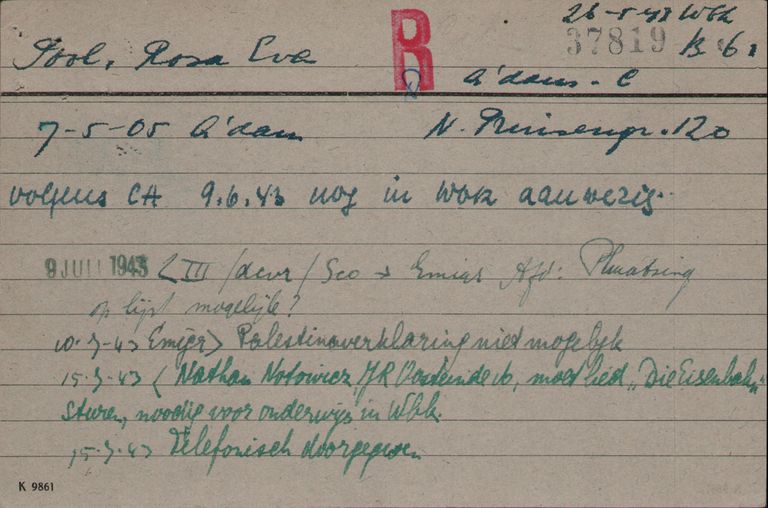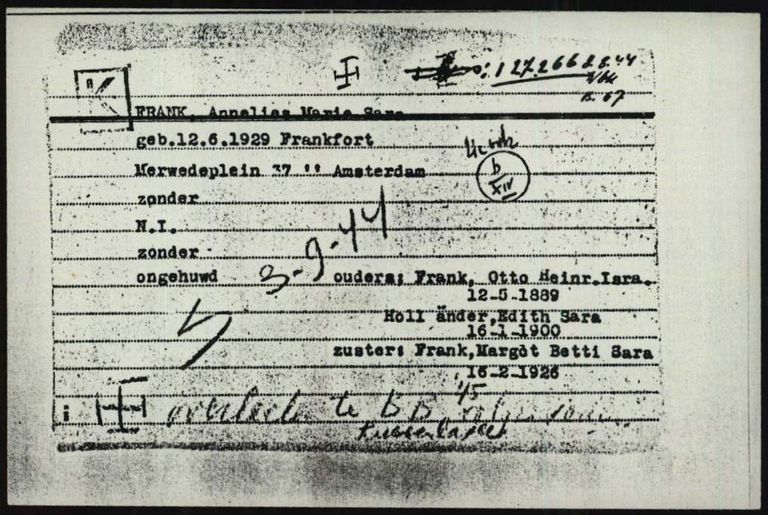Page of
Page/
- Reference
- Intro


The card file of the Jewish Council in Amsterdam includes index cards from various departments of the Jewish Council. It was the only representative of the Jewish community in the Netherlands that was recognized by the Nazis. Each index card from the card file contains personal information about Dutch citizens and foreigners residing in the country, including many refugees from Germany, who were categorized as “Jewish” by the Nazis. After the end of the war, the Netherlands Red Cross (NLRC) continued to use them in order to find out what happened to the Jewish population and to inform relatives.
The Arolsen Archives thank Raymund Schütz for his assistance in describing this document.
The card file of the Jewish Council in Amsterdam includes index cards from various departments of the Jewish Council. It was the only representative of the Jewish community in the Netherlands that was recognized by the Nazis. Each index card from the card file contains personal information about Dutch citizens and foreigners residing in the country, including many refugees from Germany, who were categorized as “Jewish” by the Nazis. After the end of the war, the Netherlands Red Cross (NLRC) continued to use them in order to find out what happened to the Jewish population and to inform relatives.
The Arolsen Archives thank Raymund Schütz for his assistance in describing this document.
Questions and answers
-
Where was the document used and who created it?
The Netherlands were attacked and occupied by the German Wehrmacht in May 1940. The German authorities passed a series of very harsh anti-Jewish measures, which severely restricted the lives of those affected.
The card file was created in the autumn of 1941 by various departments of the Jewish Council in Amsterdam. As a result, it contains a wide variety of card files. This explains why the cards have different handwritings, typewriting, ink color, and stamps. The place and time when the card files were issued also varies.
The “Polizeiliches Durchgangslager” (Police Transit Camp) Westerbork was the starting point from which Dutch Jews were deported. After July 1942, it was also referred to as the “Polizeiliches Durchgangslager für Juden” (Police Transit Camp for Jews). From this time onwards, the primary purpose of the camp (which had been set up as a central refugee camp by the Dutch government in 1939) was the deportation of the Dutch Jewish population that was detained there. Between mid-July 1942 and September 1944, the deportation trains left the Netherlands for the concentration and death camps in eastern Europe. The German occupation authorities decided who was deported and when.
The Jewish Council in Amsterdam had a field office in Westerbork, the Antragsvorbereitung (application preparation office), which worked hand in hand with what was known as the Antragstelle (application office). Jews were allowed to apply with this application office for a deportation exemption, but the Jewish Council was only allowed to inform of a possible exemption and to act in an advisory capacity. The decision as to which Jews received one of the coveted “Freistellungs-Stempel” (exemption stamps) could only be made by the Zenralstelle für jüdische Auswanderung (Central Office for Jewish Emigration) in Amsterdam and the German headquarters in Westerbork.
All Jews arriving at the Westerbork camp were registered in the central file of the Antragstelle (application office). It was destroyed in September 1944 on the orders of the camp commander. Only the index cards of the slightly more than 800 Jews who were still in Westerbork at the time of liberation on April 12, 1945 have been preserved.
The Netherlands Red Cross (NLRC) continued to use the card file after the end of WWII. The NLRC staff used the cards to collect information on the victims of Nazi persecution and to inform survivors about the fate of their relatives. A lot of the information on the cards was taken from other sources, such as transport and deportation lists. The Nederlands Volksherstel (NVH) also worked with the card file and created index cards for survivors of Nazi persecution. The NVH was an aid organization that assisted survivors and the rebuilding of the Netherlands after the war. In 1949, the card file was moved from Amsterdam to the NLRC offices in The Hague.
- When was the document used?
The Dutch armed forces surrendered five days after the German Wehrmacht invaded on May 10, 1940. Half a year later, in January 1941, the German occupiers ordered that all Jews living in the Netherlands be listed in a central register (“Verordnung zur Anmeldung von Personen, die ganz oder teilweise jüdischen Blutes sind”, No. 6/41 (directive on the registration of persons who are wholly or partly of Jewish blood)). According to the Nazis, any person with at least one Jewish ancestor was considered “Jewish”. Personal information including addresses were collected by the municipal offices and sent as lists to the Rijksinspectie van de Bevolkingsregisters (BZK) in The Hague, which was responsible for supervising the population registers nationwide.
On February 12, 1941, the Jewish Council in Amsterdam (in Dutch: Joodsche Raad voor Amsterdam) was founded on the orders of the German occupiers and placed under German administration. In October of 1941, the Jewish Council began to set up its own card file for all Jews in the Netherlands, as instructed by the central office.
The Zentralstelle für jüdische Auswanderung (Central Office for Jewish Emigration) was founded in Amsterdam in March 1941 in order to coordinate and monitor the deportations of Jews to concentration and death camps – euphemistically referred to as “Aus- und Umsiedlung” (resettlement and relocation). Together with the Rijksinspectie, the central office created a so-called “Judenregister” (Register of Jews) with the registration data. The Jewish Council in Amsterdam had to render support and provide administrative staff, among other things. The files of Rijksinspectie and the central office as well as the forms of Regulation 6/41 were completely destroyed shortly after the war.
From July 1942, the deportation lists for the Jewish population of the Netherlands became the basis of the “Judenregister” (Register of Jews). The Jewish Council did not have access to these documents, but it received the lists of the Jews summoned on the day before they had to report for transport to Westerbork. From these lists, the Jewish Council was able to delete persons who were considered indispensable, at least temporarily, and note this information on the index card of the card file.
The Netherlands Red Cross (NLRC) and the Nederlands Volksherstel (NVH) created some of the index cards from the Jewish Council card file in Amsterdam and sorted them into the existing card file after the war.
- What was the document used for?
The Jewish Council’s card file, which still exists today, was used by the Jewish Council as the foundation to register applications for exemption from deportation, but also for documenting the fate of Dutch Jews. In addition to personal information, deportation exemptions, so-called Sperren, were noted on the index cards. Each Sperre (deportation exemption) was assigned a unique number. This reveals the reason why the person was exempted from deportation. The number was noted on the index cards of the Jewish Council and on identity cards. Nevertheless, this only offered temporary protection against deportation.
Those who were unable to obtain a coveted exemption stamp had to expect to be summoned for “Arbeitseinsatz” (labor assignment) any day. That was the misleading term used by the German authorities for deportations. Jews who wanted to avoid deportation and who were unable to flee abroad had only two options: Either change their name and get fake papers, or – as in the case of the family of Anne Frank – hide and hope that the German occupation will end. More than 20,000 did so to escape the occupiers.
In the summer of 1942, the mass deportation of the Jewish population began in the Netherlands. At the end of September 1943, the Jewish Council in Amsterdam was finally dissolved by the German authorities and the council members were taken to “Polizeiliches Durchgangslager Westerbork” (Police Transit Camp Westerbork). Only a small number of Jews were able to obtain an Ausnahmebescheinigung (certificate of exemption). This kept the administrations in Amsterdam and Westerbork up and running.
Dutch Jews were first brought to the “Polizeiliches Durchgangslager Westerbork” (Police Transit Camp Westerbork). From mid-July 1942 to January 1945, people were deported from there to concentration and death camps as well as smaller internment camps. In over 93 transports, about 107,000 Jews in total were deported on the Dutch and German Reichsbahn (German National Railway), most of them to the Auschwitz-Birkenau and Sobibor death camps. About 75% of Dutch Jews were victimized by Nazi persecution. It was the highest death rate for any Jewish population in Western Europe. Only about 5,000 Jews from the Netherlands survived the Holocaust.
- How common is the document?
Almost every person in the Netherlands who was classified as “Jewish” by the Nazis was given an index card. In some cases, additional index cards were made for individuals if there wasn't any more space on the original card.
Unlike the German Reich, the Dutch registration authorities had exact information, such as addresses, but also the religious affiliation of the grandparents, which is why even thousands of non-denominational citizens were declared “Jewish” due to their ancestry. Around 160,000 citizens of the Netherlands were registered as “fully” or “partially Jewish”, 22,000 of whom were of foreign origin. Over 140,000 people were considered “Volljuden” (”full Jews”) because of their origins or because they had three or four Jewish grandparents. Jews who had fled the German Reich or the Generalgouvernement (General Government) to the Netherlands before Nazi persecution were also given index cards.
The card file of the Jewish Council in Amsterdam was microfilmed in the 1970s. In 1980, the NLRC handed over 67 microfilms to the International Tracing Service (ITS), the predecessor of today’s Arolsen Archives. The documents on the microfilms were printed out in 1988 and inventoried in the archives. They are kept in a sub-collection. The black and white back enlargements were scanned in the early 2000s. In 2020, the Arolsen Archives received 157,690 new high-resolution color scans. The original index cards from the card file of the Jewish Council in Amsterdam were transferred from the Nationaal Archief to the Joodse Cultureel Kwartier in Amsterdam in January 2021.
- What should be considered when working with the document?
The card file of the Jewish Council in Amsterdam includes a wide variety of files. Some of the index cards are from the time of the war, while others were only created after the Netherlands were liberated. The information on the cards therefore varies significantly. The personal information of Jews were recorded on almost all of them. But they also contain many errors, as birth dates were sometimes mixed up or dates are incorrectly stated for reasons unknown.
Details about individual fates and persecution were only added by the NLRC in the post-war period. However, incorrect information is sometimes also present here and the card file is also not exhaustive – especially for Jews who lived in so-called “Mischehen” (mixed marriages), i.e., those married to a non-Jewish spouse, the Jewish Council did not create index cards.
After the war, the files of various departments of the Jewish Council and the application office Westerbork were compiled. The index cards were rearranged according to a phonetic-lexicographical system and supplemented by overview cards for the most common names and spellings.
If you have any additional information about this document or any other documents described in the e-Guide, we would appreciate it if you could send your feedback to eguide@arolsen-archives.org. The document descriptions are updated regularly – and the best way for us to do this is by incorporating the knowledge you share with us.
Help for documents
About the scan of this document <br> Markings on scan <br> Questions and answers about the document <br> More sample cards <br> Variants of the document






